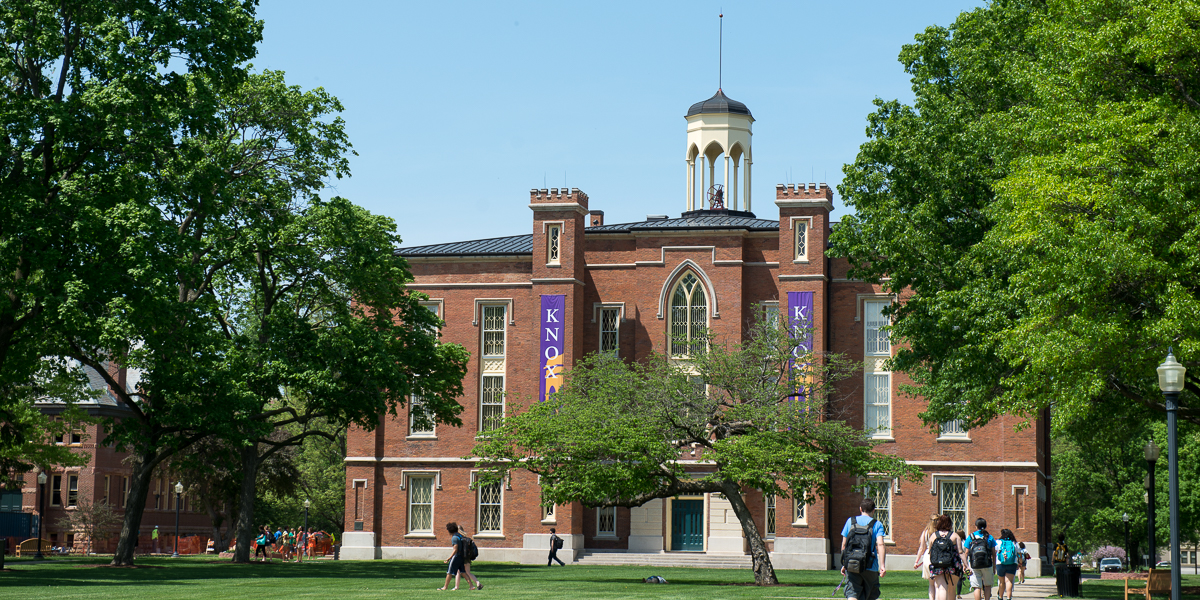

Venture Boldly

Random Notes on the Trees of Knox

A top priority for the American college is that "the site must be beautiful," commanded architect Charles Klauder in 1929, designer of several campuses and dozens of academic buildings. Knox has always taken these words to heart; having planted the College in the flat prairie, they promptly aimed to enhance the campus with trees. The 1868 catalog bragged that "nearly three thousand young and vigorous trees have been set out, which begin to afford a refreshing shade, to beautify and embellish the Institution." And the results made an impact. According to Knox psychology professor Frank McAndrew's book Environmental Psychology, "the amount of vegetation and wildlife, the size of trees, and the density of trees [are] all positively related to increased feelings of pleasure in the environment."
Trees have defined more than just "The Way to Knox" -- the beloved colonnade of elms north of Old Main. For many years, an abundance of trees allowed Knox to define itself as a "Campus Woodland." Knox today stands between its recent past as a forested campus and its 19th century origin on a flat prairie. Large and small; planted and cut down; studied, neglected and celebrated, trees are natural punctuation marks in the story that is ours.

Biology students learn to identify trees by studying them on campus. Art students have used trees both as subjects and objects for their work. At Green Oaks, Associate Professor of Art Tony Gant created two large sculptures cut from non-native trees.
For most of the year, they're fine; for several weeks in the spring, they're spectacular. Knox's flowering trees include a dozen magnolias on the walk between Seymour Union and south-campus residence halls.

Originally known as College Park, the one-square block across South Street from campus was sold by Knox College to the City of Galesburg in 1870. Dr. John Van Ness Standish planted more than 100 trees in the park that was eventually named in his honor. Neither recreational space nor urban forest preserve, Standish Park is officially an arboretum, a living museum that now comprises 137 trees and shrubs. The modern catalog of tree names and locations was started by Knox students in the 1950s. Today, it's popular with Galesburg grade school students for the leaf collection assignment in science classes.
Beetles are formidable tree foes. Beetles spread a fungus that wiped out elms in the 20th century. Burrowing under the bark as they feed, grubs of the emerald ash borer are killing ash trees in the 21st. Knox grounds staff were the first in Galesburg to officially report ash borer damage, spotted on a tree by Prats Soccer Field. "When you see leaves sprouting from the trunk, it's a sign the tree is already overwhelmed," says Grounds Director Jake Morgan. Some 50 campus ash trees will need to be removed.
How many trees are on the Knox campus? Good question -- we're working on it. Early maps were schematic, not scientific. In 1959, biology students drew a map of more than 100 trees in the oldest part of campus. In 2011, a biology student began but did not finish an inventory using Global Positioning System equipment. In 2013, a team of computer science students mapped some trees for a database of campus memorials -- also using GPS, which will make it possible to merge and update survey data.
Managing trees on college campuses would be easier "were it not for the danger of the sentiment prevailing against cutting down any thriving tree." So states the historic tome College Architecture in America. In spring 2013, a group of students staged a brief vigil at the stump of a large maple cut down on West Street, near the Umbeck Science Mathematics Center. A campus-wide e-mail discussion ensued, in which it was explained that the tree, dangerously hollowed by ants, belonged to the City of Galesburg and was removed for a sidewalk that will make the area safer for students.
Q: When is the best time to plant a tree? A: Twenty-five years ago. "Large trees [are] needed [because] small saplings
do not fill the gaps," observed the Knox Alumnus in 1964, after 78 elms came down due to Dutch Elm Disease. Large trees are also expensive, prompting the College to ask for donations to recover from what a trustee described as the "tree disaster" of the '60s. Today, an informal policy is to plant two trees for every one that's removed, and trees are an integral part, not an afterthought, in the campus landscape planning now underway.

A "giant green dome" once ruled the south lawn of Seymour Union. "Exultingly you spread your mighty strong ribbed branches far and wide," said the 1911 Gale. "Live on, most noble elm!" proclaimed Knox professor Alfred Newcombe at a formal dedication ceremony in 1929. The historian compared "Knox's Grand Old Tree" to Revolutionary War hero General Henry Knox, and it was from thence known as "The General Knox Elm." An entire graduating class could stand in its shade, which grew to a diameter of 143 feet by 1964, when it was felled by the fungus that also took down "Big Ben," its equally famous counterpart at the former Lombard College in Galesburg, as well as countless anonymous casualties.

Unlike the "General Knox Elm," the ginkgo outside Seymour Library can't claim a nickname or a dedication ceremony. But it does have its own webpage, created by dedicated fans who work in the library. They keep a close eye on changes, get reports on its condition, and hold an informal contest to predict when its leaves will drop every fall -- often on a single day. "I adore that tree," says Jason Connell '06, a public services assistant in the library. "It's a big part of our lives."
1870
Barnabas Root receives degree
Knox was one of the first colleges in Illinois to award a degree to a black student